Samsung Galaxy Note 10.1 (2014 Edition) Review: Wi-Fi Vs. LTE
Today's review of Samsung's Galaxy Note 10.1 (2014 Edition) includes the LTE-capable and Wi-Fi-only tablets, allowing us to compare Samsung's own Exynos 5 Octa platform to Qualcomm's Snapdragon 800. Can either configuration usurp Apple's iPad Air?
Why you can trust Tom's Hardware
Results: GPU Core Benchmarks
3DMark Ice Storm Unlimited
Futuremark has become a name synonymous with benchmarking, and the company's latest iteration of 3DMark offers three main graphical benchmarks: Ice Storm, Cloud Gate, and Fire Strike. Currently, the DirectX 9-level Ice Storm tests are cross-platform for Windows, Windows RT, Android, and iOS.
Ice Storm simulates the demands of OpenGL ES 2.0 games using shaders, particles, and physics via the company's in-house engine. Although it was just released in May of last year, the on-screen portions of Ice Storm have already been outpaced by modern mobile chipsets, with Nvidia's Tegra 4 and Qualcomm's Snapdragon 800 both easily maxing out the Extreme version (1080p with high-quality textures). However, Ice Storm Unlimited, which renders the scene off-screen at 720p, is still a good gauge of GPU-to-GPU performance.

The 3DMark results are quite surprising. For one, Overall score doesn't vary as much as we expected among the Snapdragon 800, Exynos 5 Octa, Tegra 4, and Apple A7. The Tegra Note 7 finishes on top with 16,567 points, followed closely by the iPad Air. The Snapdragon 800-powered Note 10.1 (2014 Edition) LTE scores roughly 15,200 points, followed by the Exynos 5 Octa-powered Note 10.1 (2014 Edition) Wi-Fi and 2013 Nexus 7.
While the Overall scores are close, the Graphics and Physics scores are all over the place. In Graphics, the iPad Air and its PowerVR G6430 engine obliterate the competition. The Tegra 4 is surprisingly far behind in second place, while the Adreno 330 follows in third.
The Physics scores yield the biggest surprise, though. Nvidia's Tegra 4 does well, helping it secure the best Overall score. The Snapdragon 800-powered Note 10.1 (2014 Edition) LTE finishes with the second-best Physics result, while Apple's iPad registers the worst Physics score among all five tablets (which is why the iPad finishes in second when the Overall number is tabulated). Since the Physics test is CPU-bound, these results imply that the iPad's dual-core A7 likely limits performance in this particular metric.
Anomaly 2 Benchmark
Anomaly 2 is a game published by 11 bit studios and available in the Google Play store. The title's creators also publish a benchmarking tool, Anomaly 2 Benchmark, which lets you see your device will fare in the full game.
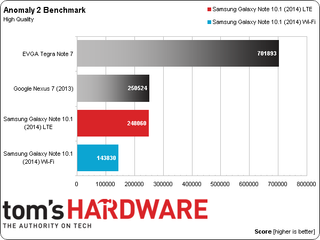
Despite its real-world pedigree, the Anomaly 2 Benchmark is quite graphics-dependent, and the Tegra Note 7 absolutely smashes its competition in this metric. That's a bit surprising, given that 11 bit studios has stated that while the Tegra 4-powered Nvidia Shield is a good performer, the Galaxy S4, Galaxy Note 3, and even Xperia Z1 perform better.
Nevertheless, the Note 7 finishes with almost three times the score (~700,000) of its closest competitors. In almost a dead heat, the Adreno 320-powered Nexus 7 (2013) finishes in second place,closely followed by the Adreno 330-powered Note 10.1 (2014 Edition) LTE. The Note 10.1 Wi-Fi's Mali-T628 ends up in last place.
Basemark X 1.1
Basemark X 1.1 is a benchmarking tool by Rightware that utilizes the popular Unity game engine, allowing for device comparisons across a wide range of platforms, including Android, iOS, and Windows Phone 8. This also has the advantage of making the benchmarks correlate well with the real-world performance of numerous games available on the market.

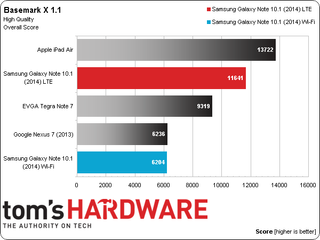
In Basemark X 1.1, the iPad Air dominates its competition; the Adreno 330-equipped Note 10.1 (2014 Edition) LTE follows behind by a significant margin, and the Tegra Note 7 trails it. The Mali-T626-powered Note 10.1 (2014 Edition) Wi-Fi does fall slightly behind in the high-quality test compared to the medium measurement—enough for the Nexus 7 (2013) to surpass it.
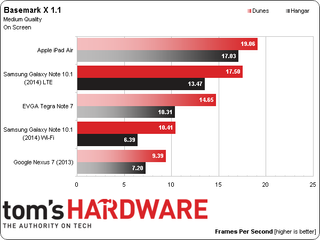
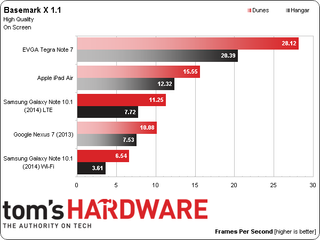
In the Basemark X 1.1 Medium Quality On Screen test, Apple's iPad Air beats the two Galaxy Note 10.1s. In the High Quality version of this test, the Tegra Note 7 surpasses not only the LTE Snapdragon-based Note 10.1, but even the iPad Air. Meanwhile, the Nexus 7 beats the Exynos-based Note 10.1 to reinforce how well this benchmark shows the punishing nature of driving a high-resolution output.
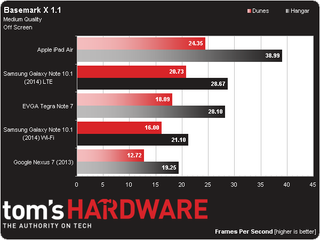

In the Off Screen test, you can see that once resolution is taken out of the equation, both versions of the Galaxy Note 10.1 (2014 Edition) fall within striking distance of the competition.
Once again, the Wi-Fi model places significantly and consistently behind the LTE model.
GFXBench 3.0
Kishonti GFXBench 3.0 is a cross-platform GPU benchmark supporting both the OpenGL ES 2.0 and OpenGL ES 3.0 standards. It comprises game-like scenarios, as well as lower-level tests designed to measure specific subsystems. See GFXBench 3.0: A Fresh Look at Mobile Benchmarking for a complete test-by-test breakdown of this suite.
In the GFXBench 3.0 On Screen tests, we clearly see the impact of running at 2560x1600, as both Note 10.1 (2014 Edition) tablets perform pretty poorly compared to the iPad Air and Tegra Note 7.
Both Note 10.1s make a significant rebound in the Off Screen test, once their resolution handicap is taken out of the equation. The iPad Air still manages to finish ahead of the Mali-powered Note 10.1 (2014 Edition) Wi-Fi in the Manhattan and T-Rex tests, but is then dominated by the Snapdragon 800-powered LTE model.
In the Driver Overhead tests, we clearly see that the Wi-Fi version of the Note 10.1, powered by Samsung's own Exynos SoC, is optimized much better than the Snapdragon-based LTE model. Meanwhile, the Fill tests show the Snapdragon 800's Adreno 330 has the most raw horsepower out of any of the assembled GPU cores.
In GFXBench 3.0's Render Quality test, the Exynos 5 Octa's Mali GPU finally finds a benchmark where it outshines not only the Snapdragon SoC, but the other competitors as well. With 10 to 30 percent better scores, the Note 10.1 (2014 Edition) Wi-Fi beats the competition handily. Surprisingly, the Tegra Note 7 finishes in second place in Standard, but last in High Precision. Since it's being billed as a productivity tablet, as opposed to a purely consumption-oriented device, it makes sense that the more widely available Note 10.1 (2014 Edition) Wi-Fi model uses the Exynos 5, as render quality would be more important than frame rate in most business applications. It could also speak to why the Exynos is so favored among the no-frills entry-level ChromeOS devices, where hardcore 3D performance is practically a non-point.
Current page: Results: GPU Core Benchmarks
Prev Page Results: CPU Core Benchmarks Next Page Results: Web BenchmarksStay on the Cutting Edge
Join the experts who read Tom's Hardware for the inside track on enthusiast PC tech news — and have for over 25 years. We'll send breaking news and in-depth reviews of CPUs, GPUs, AI, maker hardware and more straight to your inbox.

EKWB reportedly plagued with financial disarray — many employees and suppliers were allegedly left unpaid for as long as four months

Adding ZIP file support to Windows 30 years ago almost got the creator of Task Manager fired

Carry-on server flexes up to 256 cores — 480TB NVMe and 4TB RAM join Ampere Altra CPU in new fly-away-kits
-
blackmagnum The only possible way Samsung mobile devices can be a worthwhile alternative to Apple is when they ditch the every-man Android and create their own tightly controlled/ managed OS like Apple. Do that and consumers might not feel like they're just buying the Samsung for the hardware.Reply -
Farrwalker On page 7. Results: CPU Core Benchmarks:Reply
Your bar graph "MobileXPRT 2013" seems to be in error.
For example, the text says, "Note 10.1 (2014 Edition) Wi-Fi leads with 300 points . . ."
but the bar is the shortest and indicates less than 150 points.
-
blueer03 You need to proofread this big time. From page 9:Reply
Samsung's Exynos-based Note 10.1 (2014 Edition) Wi-Fi holds its own against the Tegra Note 7, while the LTE version of the Note 10.1 (2014 Edition) again falls significantly behind its Snapdragon 800-powered Wi-Fi counterpart.
And this happens all throughout. The LTE is a Snapdragon, the Wifi is an Exynos. Keep repeating that to yourself as you re-write the descriptions and it will make this easier to read. -
Kevin Harrelson We got one of these for my son (age 13) to help with his school work. We got it from Best Buy and got the extended warranty. Both sound dumb, but it was actually a good move! The backlight has gone out on this thing TWICE. I happen to think that it is a lovely little tablet, but the backlight is a major reliability issue.Reply -
adamovera ReplyOn page 7. Results: CPU Core Benchmarks:
This benchmark's sub-tests produce scores in seconds (lower is better), and the overall score is given as a typical higher-is-better score, so the lowest bar indicates the fastest completion. Sorry about the confusion, I'll look into other ways to represent this test.
Your bar graph "MobileXPRT 2013" seems to be in error. For example, the text says, "Note 10.1 (2014 Edition) Wi-Fi leads with 300 points . . ." but the bar is the shortest and indicates less than 150 points.
-
adamovera ReplyYou need to proofread this big time. From page 9:
Good catch, thanks! Fixed.
Samsung's Exynos-based Note 10.1 (2014 Edition) Wi-Fi holds its own against the Tegra Note 7, while the LTE version of the Note 10.1 (2014 Edition) again falls significantly behind its Snapdragon 800-powered Wi-Fi counterpart.
And this happens all throughout. The LTE is a Snapdragon, the Wifi is an Exynos. Keep repeating that to yourself as you re-write the descriptions and it will make this easier to read. -
Tomtompiper The 2014 is almost 5 months old and has been superseded by the Amoled screened Galaxy Tab S 10.1 which wipes the floor with the opposition. http://www.gsmarena.com/samsung_galaxy_tab_s_105-review-1097.php Do try to keep up!Reply -
adamovera ReplyThe 2014 is almost 5 months old and has been superseded by the Amoled screened Galaxy Tab S 10.1 which wipes the floor with the opposition. http://www.gsmarena.com/samsung_galaxy_tab_s_105-review-1097.php Do try to keep up!
Actually, you'd think this has been phased out, but it's the current 10-inch Galaxy "Note" product, meaning it has the S Pen. The Galaxy "Tab" S does not - still unclear to me what makes the "S" stand out. I believe Samsung is literally attempting to offer an alternative product to every single other device in existence - complete mobile domination. I lost count of their current "Galaxy" line at 11 products, and that was awhile back.
The duo of Note 10.1 (2014)'s came in very handy both as comparison data in other articles and as testbeds for compiling our benchmark suite. Unfortunately, the article had to be pushed back several times, but the huge hardware difference between products carrying the same name was always something we wanted to illustrate, initially for the chipset-vs-chipset angle, but later for the optimization aspect as well. We're currently working through a small backlog of mobility articles, but each will be more timely than the last. My apologies. -
Blazer1985 I really wish Samsung could help the end user distinguish what they are buying. The 2 Note are classified as "LTE" and "WIFI ONLY" which sounds like 2 equal devices except for the sim card slot while they actually have a totally different soc.Reply -
vaughn2k ... and Samsung prices are now on par with Apple's. others are okay. Will wait for Asus and other competition. Should be cheaper though...Reply